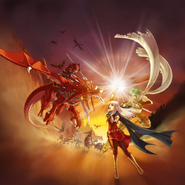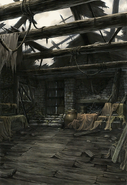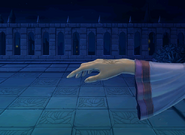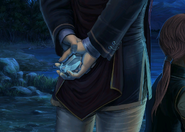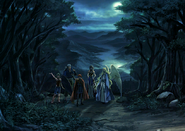Fire Emblem: Radiant Dawn is a tactical role-playing game developed by Intelligent Systems and published by Nintendo. It is the tenth Fire Emblem series title and the first and only entry on the Wii. The game is a direct sequel to the events of the Nintendo GameCube title Fire Emblem: Path of Radiance.
Development[]
Radiant Dawn was first publicly announced as in development on May 9, 2006, at the Electronics Entertainment Expo, or E3. The game uses an updated version of the same engine used for Path of Radiance, depicting its strategy gameplay with 3D polygonal models and environments.
Setting[]
- See also: Tellius Series
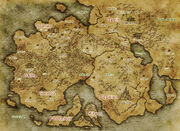
The continent of Tellius, with its seven nations and the cities within them.
Fire Emblem: Radiant Dawn begins three years after The Mad King's War, in the year 648. Daein, the war's instigator, and the victorious nation Crimea are still in the process of rebuilding. Although Crimea is ruled by Queen Elincia, Daein lacks a proper successor and is instead ruled by the occupation forces of the Begnion Empire, who oppresses the citizens by sending all of Daein's men of fighting age to internment camps, intent on utterly destroying Daein as a country.
A small resistance force, known as the Dawn Brigade, formed in response to fight back the occupational army. Led by Nolan, a seasoned fighter, Micaiah, a young girl with a gift of foresight, and backed by her friend Sothe, a young but deadly Rogue who had fought with Ike in the previous war, the brigade continuously evade Begnion's relentless pursuit, while gaining the support of Daein's crushed citizenry in the process.
Plot[]
Radiant Dawn is divided into four parts. Each part is structured similarly, beginning with a prologue chapter that introduces the situation, followed by a series of chapters that are resolved with an "Endgame" chapter.
Part I: Silver-Haired Maiden[]
Part I consists of 9 chapter stories, including a prologue and endgame about Micaiah and the Dawn Brigade's involvement with the liberation of Daein from Begnion occupation.
Fighting a hopeless struggle, the Dawn Brigade hears of a man who claims to be the son of Ashnard, Pelleas, the apparent heir to the Daein throne and leader of the Daein Liberation Army. When the Dawn Brigade finally meets up with this force in the eastern deserts and discovering that he is a decent man, unlike his alleged father, they unite and begin the first real plans to free Daein from the occupational army.
Under Micaiah's command, the Daein Liberation army waged campaigns against the Begnion garrison across Daein, having a foothold in key locations across Daein and soon on the march back to the capital of Daein, Nevassa. At the moment when they begin their march, it is also revealed that Begnion's empress Sanaki has taken notice of the atrocities committed in Daein, and has ordered all of Begnion's remaining troops there to stand down. This angers Begnion's senators, who were largely responsible for the occupation and its cruelty. Still, in lieu of the edict, they abandon the remaining occupational forces to their fate, causing its leader, General Jarod, to realize that the senator in charge of the occupation, Numida, had betrayed and framed him.
Knowing that Numida and the rest of the Senate would work to silence Jarod and his soldiers, to prevent them from being implicated on the incidents, and knowing that the end was near, Jarod resolved to at least exact his revenge on Micaiah due to driving him to a corner. On the evening of a celebration at the news of Sanaki's intervention, Micaiah is completely surrounded by Jarod's forces after she left the celebration alone, seeking to kill her to put an end to the real symbol of hope of the Liberation Army, dismissing Pelleas as worthless in comparison to her.
As they close in to do the deed, a towering figure warps in to defend her, being none other than the Black Knight, presumed dead by Ike's hand during the war. With the sheer power of his blade work, the Black Knight worked with Micaiah to defeat Jarod and his soldiers, saving Micaiah in the process. Attempting to finish off Jarod himself, Jarod's aide Alder took the Black Knight's blow on behalf of his master. Upon the death of Jarod's loyal retainer, Micaiah calls the Black Knight to stay his hand against slaying him as well, in order to allow Jarod to bury his lost comrade, and face the apostle's judgment. Sothe soon arrived and instantly assumed the Black Knight to be a threat to Micaiah, but despite Sothe's objections the Black Knight swore to protect and serve Micaiah no matter what. While explaining the situation, Micaiah sensed an impending doom caused by her choice to spare Jarod.
The following day, Jarod retaliated with one last act of spiteful violence. Murdering a Begnion emissary, he took control of Daein Keep and unleashed a catapult assault on the city of Nevassa to destroy it, terrorizing its helpless populace. Seeing this, prince Pelleas, having felt completely impotent as a ruler up to this point, finds the strength to rally his soldiers and retake the capital. Led by Micaiah, the Daein Liberation Army marches in a siege, into the city and retakes it by force, slaying Jarod and the remaining occupational forces in the process.
With Daein finally freed, and Pelleas is crowned as King, signing an official declaration with Begnion to recognize Daein as a free country once more. However, both the Black Knight and Izuka disappear after the coronation without a trace. This leaves Micaiah to continue operating as General of Daein's forces until the country is rebuilt. In the meantime, the merchant convoy, along with Kurth, the wolves and Rafiel, finally having safe passage through Daein, head out through Crimea and ultimately to Gallia.
Part II: Of Countries and Kings[]
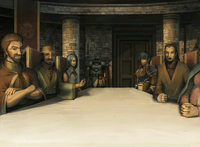
Crimea royal assembly.
Part II is a five-chapter story about the current state of Queen Elincia's three-year rule over Crimea.
Once word reaches Crimea that Daein has been repatriated, the noble classes begin to fret at the possibility that Daein may re-invade. Seeing their still new Queen Elincia as inexperienced, they begin to press her relentlessly about the issue, which forces her, after a particularly grueling council session, to seek solace in the skies on her pegasus near the edge of her country. There she is found by the royal knight Marcia, who came to cheer her up. However, they both then spot the Heron princess Leanne and her bodyguard, the Raven Nealuchi, pursued relentlessly into Crimean skies by a unit of Begnion's wyvern knights, intent on selling them to the senators for profit. Without revealing her identity as queen, Elincia and Marcia step in to save the two laguz.
In the meantime, word is spreading throughout Crimea's backcountry of a rebel insurgency, led by one of the counts. After battling through a battalion of recruit soldiers, countryfolk and former soldiers Brom and Nephenee relay word to Elincia about the uprising, believing Count Ludveck to be responsible.
To settle matters and gain evidence of his treachery, Elincia sends her retainers, Lady Lucia and the two laguz emissaries Lethe and Mordecai to Ludveck's county of Felirae. There, they manage to uncover the documents which prove Ludveck's coup but are nearly captured by his soldiers in the process.
At word of their escape, Ludveck orders the rebellion to begin, forming an army not far off from Melior. After escaping Ludveck's men, she reports her discoveries to Elincia. To answer this, Elincia sends her royal knights, led by Geoffrey to seize Ludveck. Upon arriving, however, they find the rebel army is severely undermanned and untrained. In actuality, they were merely an unwitting diversion while Ludveck's main force marched on Elincia's backup stronghold. In the process, Ludveck also managed to capture Lucia during further reconnaissance, taking her as a hostage.
As Ludveck's forces begin to overtake the stronghold, Elincia battles them directly. Lacking numbers to hold the fort, the Crimean Royal Knights manage to return in time to help rout the invading force. Ludveck is then captured and held as prisoner to await his sentence for treason. Here, he plays his final trump card, and brings Lucia out with the remainder of his troops, threatening to execute her if Elincia does not relinquish the throne to him. Despite the threat of losing her dearest friend and retainer, Elincia stands firm, refusing to let Ludveck go. She is then forced to watch as the last of the rebellion sets Lucia up to be hanged, despite the gathering crowd of booing citizens.
This last-ditch effort is thwarted, however, as Lucia is rescued by the Greil Mercenaries, who quickly and efficiently rout the remaining resistance forces. Lucia saved, Elincia meets up with Ike, and thanks him for showing up to save her. Ike, in turn, reveals that, prior to leaving for Daein on his own investigation, Count Bastian had sniffed out Ludveck's insurgency, and hired the mercenaries to help handle the situation. Here, Elincia shares with Ike the news regarding Daein, and the return of the Black Knight.
Part III: Intersecting Vows[]
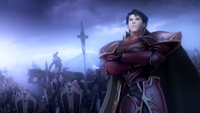
The third part of the game consists of fifteen chapters (the longest part) that follow Ike and the Greil Mercenaries.
After shattering the rebellion, they receive an unexpected visit from Ranulf, retainer to the beast king of Gallia. He warns that a war between the newly formed Laguz Alliance and Begnion is about to spark following Begnion's execution of Gallian messengers. Ike and the mercenaries pledge their support to the Laguz Alliance; however, they also fear that Lehran's Medallion, which was currently radiating with a blue flame of chaos, will release the dark god with the chaos of this war. Three years ago, Ashnard attempted to ignite a continent-wide war to create an overflow of chaos great enough to free the dark god imprisoned in the medallion. The Alliance rapidly advances through Begnion until Skrimir, the hot-headed successor to the Gallian throne, challenges and loses to Begnion's most powerful general, General Zelgius. As the Alliance retreats back to Gallia, King Pelleas sends the Daein army into the war on Begnion's side.
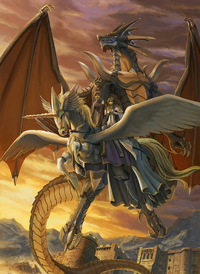
Meanwhile, Valtome, a narcissistic member of the Begnion Senate, takes control of the Begnion Central Army, and demands safe passage to Gallia through Crimea. Although Crimea and Gallia have an alliance, Elincia wishes to remain neutral, and regretfully allows Valtome's passage. The Laguz Alliance encounters the passing army and prepares for battle; however, Elincia rushes into the battlefield, lays down her weapon to show Crimea is neutral, and demands that fighting be taken outside the borders. Valtome calls her a traitor and commands his army to kill her, but she is rescued by the Greil Mercenaries and the Crimean Army. Afterwards, Valtome attempts to execute Zelgius for not aiding in the previous battle. However, the Apostle Sanaki, Empress of Begnion, stops the execution. The senate had imprisoned her and Prime Minister Sephiran in an attempt to usurp the throne. Ike is once again put in charge of the army still loyal to the Apostle, much to his disliking.
In Daein, Micaiah and party learn why Pelleas ordered them to aid Begnion. Izuka, who was secretly aligned with the Begnion Senate, had tricked Pelleas into signing a Blood Pact with Vice-Minister Lekain, which Pelleas mistook as a treaty. If Pelleas opposes the senate, the pact will activate a curse, killing citizens of Daein each day. Micaiah's army returns to the battlefield to prevent the senate from invoking the pact, while Ike's army marches through Daein to reach Begnion. Pelleas discovers that the only way to destroy the pact is to murder the pact-maker, and asks Micaiah to kill him. In the second playthrough, the player can spare Pelleas; otherwise, he is killed. Queen Almedha then reveals that Pelleas is still bound to the pact, but the curse can be lifted by destroying the pact itself, which is in Lekain's possession.
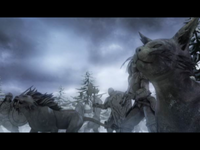
Soldiers, Beorc and Laguz, petrified by Ashera's judgment.
During a battle, Ike's sister Mist receives telepathic messages to use the Galdr of Release to awaken the dark god within the medallion. When Sanaki sings the galdr, nothing happens, but when Micaiah sings, she releases Yune, the dark god. Yune possesses Micaiah's body and tells the party the truth about her and Ashera. The term dark god is a misnomer. Yune is a goddess of freedom and chaos, and Ashera is her counterpart, order and restriction. Yune was sealed away because Ashera thought of her as an imperfection. Because they are linked, if Yune is awake, Ashera also awakens. If they were awakened by the galdr, Yune and Ashera would meet to judge the world and decide its fate; if they were awakened by the spirit of chaos, the world would be destroyed. However, Ashera has already given her judgment and petrified everyone on Tellius, though everyone with a strong spirit was kept safe. This revelation sparks the fourth and final part of the game.
Part IV: Gods and Men[]
The final part of the game is divided into a prologue, five chapters, and a five-part Endgame. With all sides on equal terms, Yune organizes three armies to travel to the Tower of Guidance, where Ashera has slumbered these past years. Lekain has survived the petrification and restored many of the petrified soldiers to their normal states, forming them into the Disciples of Order to fight against Yune's forces. Sanaki confronts Lekain, who reveals that she did not inherit the ability to hear the voice of the goddess, a trait only given to the first-born children of the first apostle's lineage.
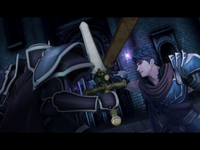
Ike fights the Black Knight for the last time
The armies reach the tower and begin the ascent. They first kill Lekain and tear up the blood pact. In the second battle, Ike faces the Black Knight, who is revealed to be Zelgius, and kills him.
Next, they confront the Dragon King Dheginsea, who has decided to accept the goddess's judgment, and defeat him after Yune grants her blessing to the party. Outside Ashera's chamber, they meet Sephiran, who reveals that he caused all of the recent wars. Sephiran is revealed to be Lehran, who aided Ashera and the Three Heroes: Soan of the Beast Tribe, Dheginsea of the Dragon Tribe and Altina of the Beorc, in sealing Yune. They made a covenant promising Ashera that no war would be waged for 1000 years, and she would reunite with Yune to become Ashunera, the Goddess of Dawn. Due to the Serenes Massacre, Sephiran decided men could never live peacefully and wanted Ashera to destroy them all. In the first playthrough, Sephiran is defeated and willingly dies in Sanaki's arms, but in the second playthrough, he can be allowed to live and will join Yune's side. After Sephiran's defeat, the party enters Ashera's chambers. Micaiah gives Ike the remainder of Yune's power for one last strike (for only Ike can beat her). After Ashera is defeated, Yune saves all the petrified people and leaves as well.
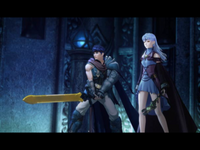
Ike and the Yune-possessed Micaiah in the final battle against Ashera.
The game ends as everyone leaves to continue their lives, which is told through a lengthy epilogue. Micaiah becomes the Queen of Daein. If Pelleas is still alive, he reveals he is not Almedha's son and stays with Micaiah as a member of the royal court. If certain conditions are met, it is revealed that Soren is Almedha's son. Sanaki realizes Micaiah is her older sister, and they agree to make peace between their countries. Ike leaves the continent forever to explore a distant land, either by himself, with Soren, or potentially Ranulf depending on his in-game supports. As mentioned with Ike, if certain support conversations are attained, characters may get married or have other changes to their endings.
Characters[]
See the main article, List of characters in Fire Emblem: Radiant Dawn.
Radiant Dawn features 73 total playable characters in the roster. Due to the storyline jumping between various factions of Tellius, character availability changes throughout the story.
Chapters[]
See the main article, Chapters (Fire Emblem: Radiant Dawn).
Gameplay Mechanics[]
Radiant Dawn carries over the gameplay mechanics of Fire Emblem: Path of Radiance, with some changes.
Modes[]
Both the Japanese and English versions of the game provides "Normal" and "Hard" modes, with the third mode, "Maniac", being unlocked after completing the Normal mode. In English-language releases, the three modes were renamed to "Easy", "Normal", and "Hard". Unlike Path of Radiance the contents of the difficulty modes were not edited at all beyond their names.
Game Structure[]
The game's 45 chapters are unequally divided into four parts. Each chapter features a "leader" character, comparable to the Lord characters in previous games. For example, the leader of Part I is Micaiah, and Ike is the leader of most of Parts III and IV. Tibarn is one of the main leaders of Part IV, along with Ike and Micaiah. Other leaders, such as Elincia, Lucia, Nephenee, and Geoffrey, play minor roles. A total of 72 playable characters are available, with 42 returning from Path of Radiance.
Support System[]
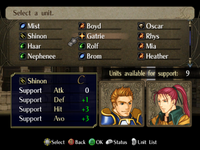
Radiant Dawn features two types of supports: Buddy supports and Bond supports. Buddy supports (simply called "Supports" in previous games) increase their characters' battle stats dependent on the elemental affinity and support level of both Buddies. Unlike in previous games, characters can be Buddies with any other character, but can only have one Buddy at a time. Also, Buddy supports can be deleted. Characters in Buddy supports can have a short conversation during each battle. Bond supports, which also appeared in Path of Radiance, are between two specific characters and are always present.
Because any character can form a support relationship with any other character, the conversations themselves have been simplified and are based on templates, in which the initiating character makes a stock statement while inserting the recipient's name, and the recipient will respond with a general acknowledgment. The more colorful dialogue that typified the support conversations in previous installments has been for the most part transferred to the Info conversations that take place between battles.
Path of Radiance Data Upload[]
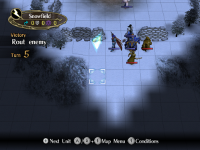
The "Fog of War return in some chapters of Radiant Dawn
If a GameCube memory card with a cleared Path of Radiance save is inserted, data can be transferred from the save file. Path of Radiance characters who have attained high statistics or weapon levels will receive corresponding boosts to their Radiant Dawn counterparts. Transferred A-level supports become Bond supports in Radiant Dawn, and the support conversations unlocked can be read in a support library after the game is completed. Coins collected are transferred to Ike in Part 3, where they can be used in the game's weapon forging system.
The North American version of Radiant Dawn launched with a bug that causes the game to freeze when using this feature with a memory card containing Easy Mode save data from Path of Radiance. If playing the game using a game disc with this bug, the only way around it, other than not using the feature at all, is to use a GameCube memory card that only has Normal or Hard Mode Path of Radiance save data.
After the discovery of the bug, a fix was quickly applied. However, because the Wii and its online infrastructure were not built to allow game software patches to be downloaded, the only way for players with affected game discs to receive the fix was to mail their discs to Nintendo of America, who swapped received copies with updated discs containing the fix.
New Beorc Features[]
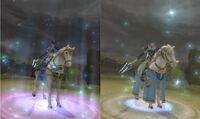
Geoffrey promoting from Lance Paladin to Silver Knight.
Beorc (human) units can now promote twice, resulting in three tiers of character classes. Most first and second-tier classes are Fire Emblem staples, such as Myrmidons and Swordmasters. Third-tier classes are the strongest of all classes; the character automatically learns their class's Occult (ultimate) skill upon promotion. To promote most characters from a second to a third-tier class, they must be raised to Level 21 of their second-tier class or a Master Crown must be used at or after level 10.
Notice: In the Japanese version, only when the Master Crown is used can a second-tier character promote to a third-tier class.
New Laguz Features[]
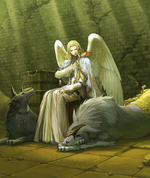
The laguz from Path of Radiance also return. They can now counterattack when untransformed, using a new weapon called "Strike," though they are relatively weak in this state (when they transform, all of their stats double except for HP and Luck). Laguz can only wield one Strike weapon, but they can upgrade it by increasing its weapon level to SS. Laguz cannot promote, but they can reach a maximum level of 40 (instead of 20). They learn their Occult skill by using a Satori Sign at level 30 or above.
A new laguz tribe has been introduced; the wolves of Hatari. They have been added to the beast tribe and share similar weaknesses to the cats and tigers. Both have a weakness for fire. Also, a new type of dragon (though not a new tribe) has also been added; black dragons (like Kurthnaga,) who have the ability to fly and are only in the royal family. Notice: even though these Dragons can fly, they do not posses Canto.
Magic and Skill System[]
The game also adds a new magic type, Dark magic, and a second trinity of magic, originally from the GBA Fire Emblem games: Dark beats Anima (Wind, Thunder, and Fire), Anima beats Light, and Light beats Dark. Skills, except locked skills, can now be removed and transferred as Scrolls. Skill capacities have been modified for beorc due to the new three-class system, and laguz have varying capacities depending on level.
Weapons[]
For a list of weapons from the game see: List of weapons in Fire Emblem: Radiant Dawn.
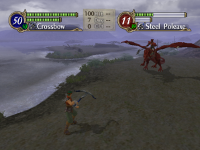
The weapon forging system introduced in Path of Radiance also makes a return with some modifications. Unlike in the previous game, which only allowed the creation of one special weapon prior to each battle, the player can now use the forge as often as desired so long as the forge is available for use and there is enough gold in reserve to pay for the weapons. Furthermore, rare coins found during battle can be traded in during the forging process to further enhance the created weapon's stats.
The breadth and variety of weapons and weapon classes has also increased. Knives, which required a special skill to use in Path of Radiance, are now classified as a full weapon category with levels matching swords, axes, bows, and lances. The SS weapon level, higher than the S of previous games, has been added. The new low-tier bronze weapons do the least amount of damage of all the weapons in the game and prevent the character wielding the weapon from performing a critical attack, but are also the least expensive and allow the most uses. Additionally, Snipers/Marksmen and Warriors/Reavers have access to crossbows and bowguns that allow the equipped unit to attack and counter-attack from melee range. These crossbows and Bowguns are some of the only weapons that don't have a Weapon Level.
Terrain and Elevation[]
The height of the landscape now has a direct effect on gameplay. Characters can climb up to higher levels at certain points. If a character is higher than an enemy, they will have much higher accuracy and deal more damage; conversely, if they are lower they will have much lower accuracy. However, only units equipped with ranged weapons, such as bows and magic tomes, can attack an enemy on a higher or lower plane. Also, while most units can climb up ledges, paladins units must use a ramp or stairway to reach higher elevations.
Version Differences[]
Radiant Dawn saw significant changes in its localized releases, seeing alterations of the script, core mechanics, and overall difficulty.
- For a full timeline of version differences, see here.
Reception[]
The game currently sits at a Metacritic average score of 78 out of 100 based on thirty-six professional reviews, which, while positive, is the worst Metacritic average of any mainline Fire Emblem game save for the limited-time Switch re-release of the original Shadow Dragon and the Blade of Light. The general consensus is that it features solid gameplay, but is also punishingly difficult in a manner that threatened to alienate newcomers. Critics of the era also commonly noted that the graphics are too reminiscent of its GameCube predecessor.
Game Informer gave the game a 7 and a 5.5 of 10 due to its staggering difficulty. The reviews emphasized that its difficulty would alienate new players to the franchise and that only diehards would have the resolution to finish. The lack of a compelling story compared to previous installments was also criticized.
Nintendo Power gave the game a 9.5 of 10. Scott Pelland, though calling the missions "fiendishly difficult," felt that it was a good thing, stating that the player must then utilize his resources fully to claim victory. He also compared it to its contemporary, the Advance Wars series, and a few older games like Final Fantasy Tactics and Ogre Battle.
1UP.com gave it a 9.0 of 10. Reviewer Michael Donohoe approved of the designer's addition of a mid-battle save option to slacken frustration. He also praised the gameplay, though largely unchanged from previous installments, as being "crazily addictive". However, he had "teensy problems" with the graphics, the changed support conversations, and the Laguz characters, which "still aren't very useful."
IGN writer Mark Bozon gave the game an 8 of 10. Though a generally favorable review, he complained of its likeness to its GameCube predecessor, the lacking overall presentation and graphics, and the absence of Wii-specific features. He did, however, give the game credit for being "a great tactical experience" with "well over 50 hours" of gameplay.
GameSpy awarded the game a 4.5 out of 5 and its Editor's Choice award. GameSpy praised the deep gameplay and story and gave a nod to the "pleasant" graphics.
Electronic Gaming Monthly awarded the game a surprisingly positive 9.0, 9.0, and 8.5 score from its three reviewers as well as a silver medal. The reviewers praised the deep, strategic gameplay and the gorgeous FMV cutscenes.
GameSpot gave the game a 6.0 out of 10, complaining about the "laughable enemies" and the punishing difficulty, which would alienate newcomers to the series. Furthermore, the game had little to no improvement graphically over the GameCube and it didn't make use of the Wii controller.
Trivia[]
- As the player advances in the game, the intro movie expands.
- By completing multiple playthroughs, the class roll will show more classes.
- This is the third Fire Emblem game to have three tiers of promotions, after Fire Emblem Gaiden and Fire Emblem: The Sacred Stones.
- Radiant Dawn is the first Fire Emblem game to feature victory animations when a playable character defeats an enemy.
- In Fire Emblem Awakening and Fire Emblem Warriors, Owain refers to a special move he's concocted with the name "Radiant Dawn".
- In the European version of the game, the notification screen saying "Player Phase", "Enemy Phase", "Other Phase", or "Partner Phase" has still letters that fade in and then out, while in the North American version the letters appear with a special graphical effect.
- Unusual to the series, during preparation for the third part of the Endgame chapter, the player must select a team of characters to take into the final battles. Whatever weapons are currently equipped by these characters is then given a blessing by Yune, giving them infinite durability. This can affect any weapon that does not already have infinite durability, including Silver weapons, Brave weapons, and custom weapons created at the forge. Ike's sword Ettard is the only weapon cannot be blessed as he is forced to have Ragnell blessed instead of any other weapons in his possession
- Radiant Dawn was the last Fire Emblem game to be released for a home console until Fire Emblem: Three Houses, released on the Nintendo Switch twelve years later.
- This is the only entry of the series to have audio in another language other than Japanese or English for the cinematics; in this case, Spanish, French, Italian and German dubs were made for the game.


